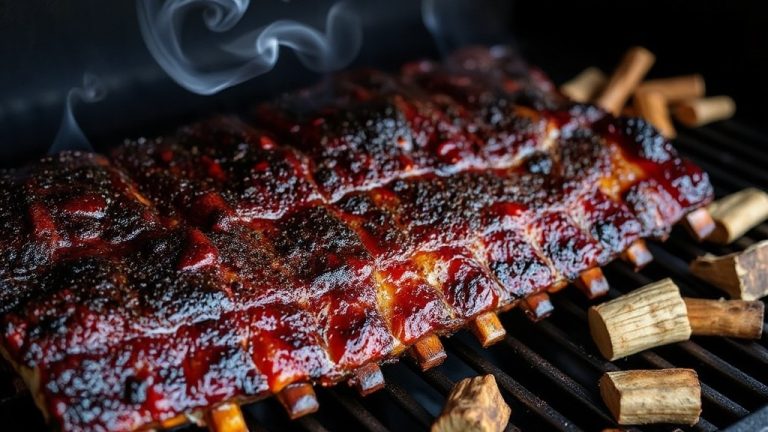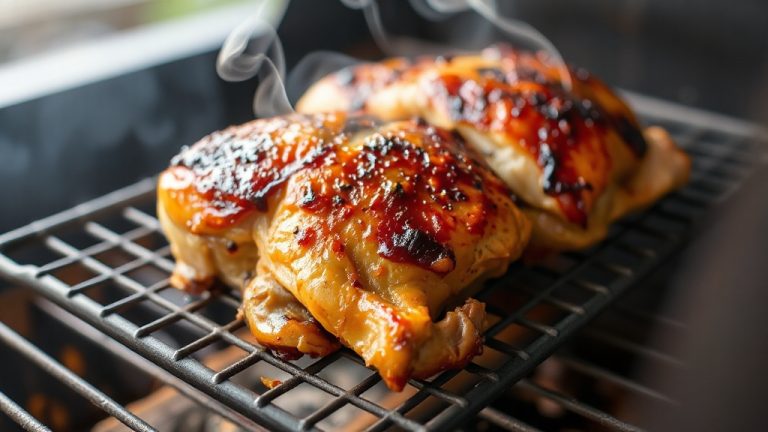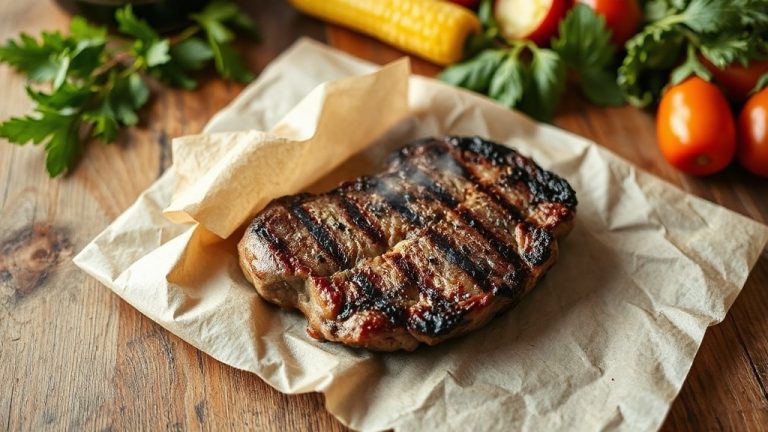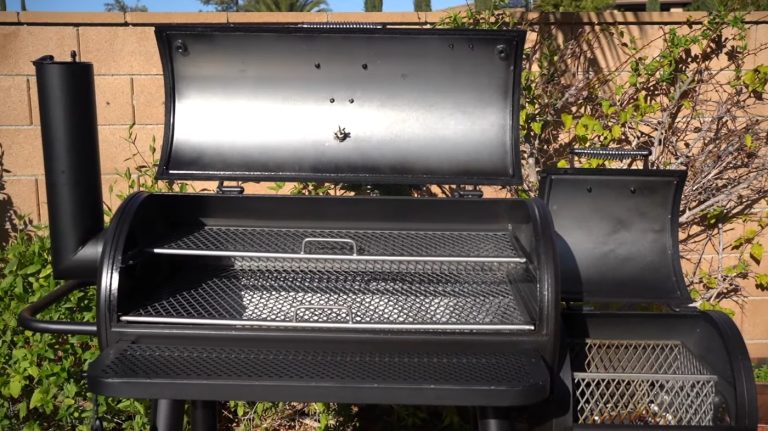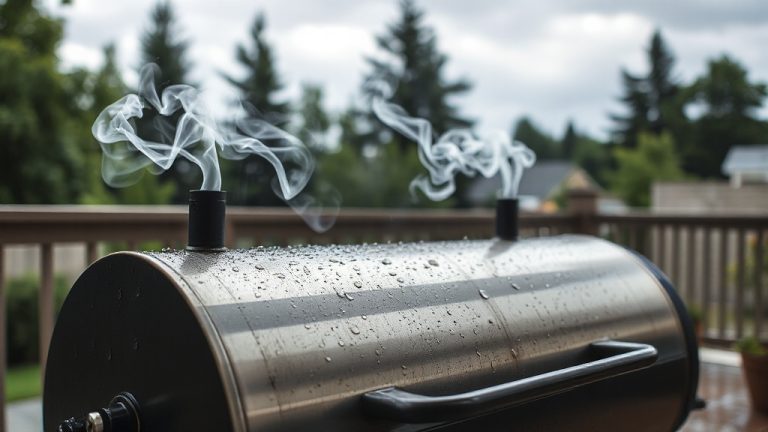How to Keep Brisket Warm if Done Early? Easy Pro Tips
If your brisket’s done early, keep it warm by loosely tenting it with heavy-duty foil to retain heat and prevent sogginess.
For longer holds, wrap it in butcher paper or double wrap with foil to balance moisture and bark texture. Store in a low oven set around 140°F–160°F or use a smoker’s warm chamber for controlled heat and humidity.
Rest before slicing to redistribute juices. Explore more techniques to master warmth and moisture control for perfect brisket every time.
Key Takeaways
- Rest brisket loosely tented with heavy-duty foil to retain heat and prevent sogginess while allowing steam to escape.
- Wrap brisket in butcher paper for breathability or foil for maximum juiciness, depending on desired bark texture.
- Hold brisket in an oven set between 140°F and 160°F to maintain warmth without overcooking.
- Use double-layer wrapping combining foil and butcher paper to stabilize temperature and preserve moisture during extended holds.
- Avoid frequent opening of the oven or cooler to maintain consistent holding temperature and prevent heat loss.
Resting Brisket With Loose Foil Tent
When you rest brisket under a loose foil tent, you retain heat while preventing steam from overcooking the meat. The loose tent traps radiant heat above 140°F, keeping the brisket warm and tender without continuing to cook aggressively.
It encourages gradual cooling, allowing juices to redistribute evenly within the meat fibers. This process is crucial for enhancing tenderness and juiciness.
Unlike tight wrapping, the loose foil tent allows steam to escape, preserving the dry, crusty bark by minimizing moisture condensation.
This balance prevents sogginess while shielding the brisket from ambient air that can dry it out. Using a loose foil tent is a simple way to maintain moisture retention without compromising bark texture.
Use heavy-duty foil and fold it loosely to avoid compressing the bark. You can also rest the tented brisket on a warm surface to enhance heat retention, holding it comfortably warm for up to two hours before serving.
Wrapping Techniques to Retain Moisture
When wrapping your brisket to maintain moisture, choosing between foil and butcher paper affects both juiciness and bark texture.
Using a double layer of foil can improve heat retention, but avoid wrapping too tightly, as it may trap excessive steam and soften the bark.
Selecting the appropriate wrap material is crucial because foil provides a tight seal for a braised texture, while butcher paper allows evaporation for a firmer bark.
Finding the right balance ensures your brisket stays warm and moist without sacrificing flavor or texture. Additionally, understanding the heat retention properties of the wrap material can help optimize how long your brisket stays warm without overcooking.
Foil Vs Butcher Paper
Although both foil and butcher paper serve to retain moisture during brisket cooking and resting, they do so in fundamentally different ways that affect the meat’s texture, flavor, and cooking dynamics.
Foil creates a nearly airtight seal, trapping all juices and steam, which maximizes juiciness but softens the bark due to moisture buildup. It also speeds cooking and locks in flavor but prevents further smoke absorption.
Wrapping at internal temps of 150°F-165°F helps manage moisture release and temperature during the stall phase. This method is especially effective when using woods like oak that provide a steady, balanced smoke flavor.
Butcher paper is porous, allowing some moisture to evaporate, which preserves a firmer, crunchier bark favored in Texas-style barbecue. It slows cooking slightly and enables continued smoke penetration, enhancing flavor complexity. This breathing effect complements the slow, consistent burn of seasoned oak wood, helping maintain an ideal smoke intensity during long cooks.
While foil is easy and inexpensive, butcher paper offers a superior balance between moisture retention, bark texture, and smoke flavor, letting the brisket “breathe” during resting for ideal results.
Double Layer Wrapping
Choosing between foil and butcher paper sets the stage for how you’ll retain moisture, but combining materials through double layer wrapping takes this a step further.
By layering two sheets—typically foil and butcher paper or two pieces of foil—you create an insulated environment that slows heat loss and traps steam, enhancing moisture retention. This method also helps manage the stall phase by maintaining a consistent temperature around the brisket.
Using an approach similar to smoking techniques and temperature control ensures the meat stays warm without drying out.
Position the brisket with the fattier side up and overlap the wraps by about half to ensure full coverage. After wrapping, roll or fold once to tighten the seal without crushing the bark. This technique stabilizes temperature, promotes collagen breakdown, and prevents evaporation during resting or extended holds.
Double wrapping is especially useful for long cooks or challenging conditions, helping you keep your brisket juicy and tender while maintaining bark texture and even heat distribution.
Avoid Over-tight Seals
Since over-tight seals trap excessive moisture, you’ll risk ending up with a soggy bark instead of the crispy crust you want. When wrapping your brisket, avoid pressing foil tightly; instead, loosely fold it to allow some vapor to escape. Using materials like butcher paper helps maintain the ideal moisture balance due to its breathability.
Butcher paper is an excellent alternative because its breathability naturally prevents over-tight sealing while retaining juices. Give the wrap some slack to accommodate juice expansion during resting, which helps maintain bark texture.
Avoid multiple compressed layers that block airflow and trap excess moisture, leading to braising rather than smoking.
When holding brisket warm, use a cooler with loosely wrapped meat and cloths to balance heat retention and airflow. Using a warming device set above 140°F allows safe and effective holding of brisket without drying it out.
Managing seal tightness carefully preserves moisture without softening the bark, ensuring your brisket stays juicy with the perfect crust.
Using an Oven for Low-Heat Holding
To keep your brisket warm without drying it out, set your oven between 140°F and 160°F for low-heat holding.
Wrap the meat tightly in foil or butcher paper to lock in moisture and prevent contamination, and consider adding a pan with water or broth in the oven to generate gentle steam for extra moisture retention.
Use a probe thermometer to monitor the oven’s temperature and make certain of consistent, safe holding conditions.
Resting the brisket in a foil boat or warmer after cooking helps juices redistribute, enhancing tenderness and flavor.
Optimal Oven Temperature
Although ovens vary, you’ll want to keep the temperature between 140°F and 170°F when holding brisket to maintain safety and quality. Most ovens set to their lowest bake setting hover around 150°F, which is ideal for long-term holding.
This temperature range aligns with industry practices where brisket is held at around 150°F for extended periods to ensure tenderness and moisture retention.
Maintaining a consistent temperature within this range also helps prevent bacterial growth and preserves meat texture, similar to controlled temperature techniques used in smoking processes.
Temperatures below 140°F risk bacterial growth, while those above 170°F can overcook and dry out your brisket.
Use a probe thermometer placed mid-rack to monitor your oven’s actual temperature, as fluctuations are common. Test it for a couple of hours before holding to ensure it stays steady within this range.
Keeping the oven near 150°F preserves moisture and texture without further cooking. Avoid opening the door frequently to maintain consistency, and consider turning the oven off a few hours before serving to gently lower the temperature closer to 140°F.
Wrapping for Moisture Retention
Maintaining the right oven temperature sets the stage for preserving your brisket’s quality, but how you wrap it plays a significant role in locking in moisture during holding.
Use heavy-duty aluminum foil for a tight seal that traps natural juices, creating a braising effect that keeps the meat tender and juicy. This wrapping method is crucial because it helps lock in moisture, preventing the brisket from drying out.
Double wrapping with foil and butcher paper adds insulation and extends moisture retention. If you want to preserve a firmer bark, butcher paper alone allows some evaporation while maintaining moisture balance.
Adding a splash of broth or apple juice inside the wrap can enhance moisture without sogginess. Place the wrapped brisket in a preheated oven at 140°F–170°F, monitoring internal temps closely. Properly sealed wrapping prevents moisture loss, ensuring your brisket stays succulent and ready to serve.
Utilizing the Smoker’s Vertical Chamber
A vertical smoker’s chamber offers a unique advantage for keeping brisket warm by promoting even heat circulation around the meat. To utilize this, maintain the smoker’s temperature between 180° and 275°F, adjusting dampers and fan speeds to stabilize heat without overcooking.
Place the brisket on racks away from direct fire to avoid hot spots. Use water or cast iron pans above the meat to maintain humidity. Keep the smoke stack partially open for continuous light smoke flow, preserving the bark while preventing drying.
Monitor internal temperatures with digital probes. Balance airflow by gradually closing vents once the holding temperature is reached. This approach ensures steady, uniform heat, preserves moisture, and keeps your brisket juicy and flavorful during extended holding times.
Holding Brisket in Warming Cabinets
Once your brisket has rested and you’ve utilized the smoker’s vertical chamber to keep it warm, holding it in a warming cabinet offers another effective method to maintain temperature and moisture. You’ll want to keep the brisket above 140°F to ensure safety and avoid bacteria growth.
Before placing it inside, wrap it tightly in butcher paper or foil to lock in juices. High-quality warming cabinets provide thermostatic control and even heat distribution, preventing drying or overcooking.
Here are three key tips for effective holding:
- Monitor internal and ambient temperatures continuously using probes and alarms.
- Avoid frequent door openings to preserve stable heat and humidity.
- Hold brisket up to 20 hours safely if temperature remains consistent near 140-145°F.
This method guarantees your brisket stays tender and ready for serving. Wrapping brisket in butcher paper during holding helps maintain moisture balance by allowing some breathability while preserving juiciness.
Cooler Holding Method for Heat Retention
Although coolers are typically associated with keeping food cold, they can effectively retain heat when prepared correctly.
Start by preheating the cooler with hot water to create a warm environment, then remove the water before placing your brisket inside. This method leverages the cooler’s insulation to extend the resting time without significant heat loss.
Wrap the brisket tightly in foil or butcher paper and avoid direct contact with the cooler’s cold surfaces by using a foil tray or rack. Seal drainage holes and latches to minimize heat escape. Using insulation techniques like towels or thermal blankets inside the cooler further reduces heat loss.
Use a high-quality insulated cooler and consider adding towels or thermal blankets around the brisket for extra insulation. Maintain the brisket’s temperature above 140°F by monitoring it periodically and avoid opening the cooler frequently.
If the temperature drops below this, reheat promptly to ensure safety and preserve quality. Proper temperature monitoring is crucial to prevent unsafe conditions during extended holding times.
Maintaining Moisture During Holding
When you want to keep your brisket juicy during holding, mastering moisture retention is vital. Moisture loss dries out the meat, so use these strategies to maintain succulence:
- Wrap smartly: Use aluminum foil for a tight seal that steams the meat in its juices, or butcher paper to retain moisture while allowing smoke penetration. Timing your wrap is essential to protect the bark and lock in moisture. Selecting a cut with good marbling and trimming before cooking also helps maintain moisture during holding.
- Increase humidity: Place a water pan near the heat source or wrap the brisket in a slightly damp cloth under foil to create a humid environment that reduces drying.
- Spritz regularly: Apply a mix of water, apple juice, and cider vinegar periodically to keep the crust moist and help break down muscle fibers, preserving tenderness.
Preparing Brisket for Serving After Holding
To serve brisket at its best after holding, you should first guarantee it has rested sufficiently to redistribute its juices evenly. This resting period is crucial because it allows the juices to redistribute throughout the meat, ensuring moistness and tenderness.
After holding, warm the brisket gently—ideally in foil at about 250°F—to avoid drying out. Before reheating, spray or brush the meat with beef broth or water to maintain moisture.
Use a probe thermometer to monitor internal temperature, ensuring it stays above 140°F for safety but doesn’t overcook.
Slice the brisket close to serving time to preserve juiciness and ideal texture. Prepare heat-retentive serving trays or containers to keep the meat warm without drying during service.
Frequently Asked Questions
Can I Keep Brisket Warm Using a Slow Cooker or Crockpot?
Yes, you can keep brisket warm using a slow cooker or Crockpot. Set it on the low heat setting and add a few inches of liquid to keep the meat moist.
Make sure the brisket is wrapped or submerged in its juices to prevent drying out. Reheat gently for 1-2 hours, monitoring the temperature to stay above 140°F for food safety and to maintain tenderness and flavor.
How Long Is It Safe to Hold Brisket Above 140°F?
You can safely hold brisket above 140°F for about 2 to 4 hours without risking bacterial growth. Beyond that, the temperature must stay consistently above 140°F, or you’ll need to reheat the brisket to 165°F before serving.
Always monitor the internal temperature with a food thermometer to guarantee safety. Holding brisket below 140°F for over 2 hours increases contamination risk, so keep it warm properly and check temperatures frequently.
Does Resting Brisket Affect Its Final Tenderness and Flavor?
Resting brisket is like giving your dial-up modem a moment to connect—it’s essential. When you rest it, the muscle fibers relax, making the meat more tender and easier to slice.
Meanwhile, juices redistribute evenly, enhancing flavor and moisture. Skipping this step means you’ll lose those delicious juices on the cutting board.
Can I Freeze Brisket After Holding It Warm for Several Hours?
Yes, you can freeze brisket after holding it warm for several hours, but you must guarantee it stayed above 140 °F to minimize bacterial growth.
Cool it quickly to below 40 °F before freezing to preserve safety and quality. Avoid freezing while still warm to prevent texture damage. Wrap it tightly to prevent freezer burn, portion for easy thawing, and reheat to 165 °F for safe, tender results.
What Is the Best Way to Prevent Brisket Bark From Softening During Holding?
To prevent brisket bark from softening during holding, avoid wrapping it in foil right after cooking. Instead, use butcher paper or leave it loosely covered to let moisture escape.
Keep the holding temperature between 140-160°F with dry heat, and avoid spritzing or adding moisture too early. Use insulated containers that allow airflow without trapping steam, and slice the brisket just before serving to preserve the bark’s crisp texture.
Choose the Best Way to Keep Your Brisket Warm and Juicy
Keeping your brisket warm without drying it out is all about using the right method, whether it’s a loose foil tent, low oven heat, or a cooler. You want to maintain moisture and flavor until serving, so your hard work pays off. After all, why rush perfection when you can hold it just right?
By choosing the best technique for your setup, you ensure every bite stays tender and delicious, ready whenever you are.

